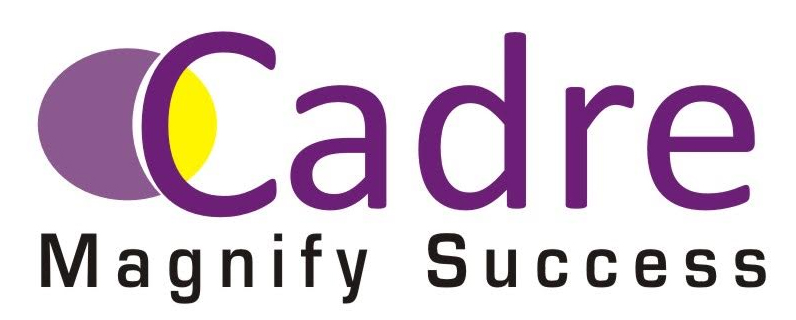a. Tutorial and Example Packages
Single-Event Upsets in CMOS SRAM
Tutorial guide | Video Demo | Input file package
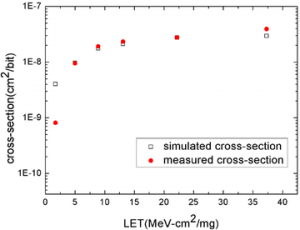 This tutorial covers the procedures of simulating Single-Event Upset (SEU) effect in an SRAM chip. SEU cross-sections under ion beams of various ion are obtained from the simulations.
This tutorial covers the procedures of simulating Single-Event Upset (SEU) effect in an SRAM chip. SEU cross-sections under ion beams of various ion are obtained from the simulations.
Excellent match with experimental data shows that Cogenda Gds2Mesh/Gseat/Genius tools based TCAD modeling can predict real-world semiconductor device SEU effect, and thus delivers simple but powerful solution for research of semiconductor device radiation effect and radiation hardening approach.
- Input:
- for Device: Layout and Process Rule
- for Radiation: Ion species and Its Energy, Incident Position, Direction
- Output:
- Tracks of Every Single Ion and Their Delta Rays
- Device’s Transient Response for Every Single Event
- How Close to Upset for Every Single Event
- SEU Cross-Section
Single-Event Upsets in CMOS SRAM
Tutorial guide | Video Demo | Input file package
 This tutorial describes a TCAD/SPICE mixed-mode simulation approach for studying Single-Event Transients (SET) in an Op-Amp chip (LM124).
This tutorial describes a TCAD/SPICE mixed-mode simulation approach for studying Single-Event Transients (SET) in an Op-Amp chip (LM124).
This BJT chip is too large to fit into TCAD as a whole, so only the device (or device pair) hit by the particle is simulated in TCAD, while all other components are handled in SPICE circuit simulator. This mixed-mode approach enabled us to study SET in larger, more complex analog circuits, without compromising on physical details.
- Input:
- for Device: Layout and Process Rule
- for Circuit: Net-list and SPICE Model
- for Radiation: Ion species and Its Energy, Incident Position, Direction
- Output:
- Device’s Transient Response for Every Single Event
Total Ionizing Dose Effects in CMOS
Tutorial guide
In this tutorial, the physics predure of TID effects and the model equations that will be implemented in Genius is outlined first. Following that, the radiation effects on leakage current, threshold and subthreshold slope of nMOSFET devices are illustrated with TCAD simulations using this physics-based model. Some process, device and circuit factors that may affect TID effect in MOSFET are described in subsequent sections.
- Input:
- for Device: Layout and Process Rule
- for Radiation: Ionization Dose Distribution
- Output:
- Carrier Distribution
- Leakage Current
- Threshold and Subthreshold Slope
CMOS Image Sensor
Tutorial guide | Input file package
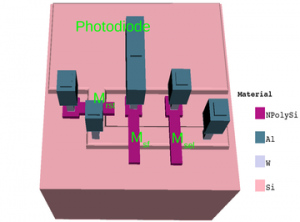 This tutorial demonstrate the modeling of a complete CMOS image sensor cell with 3D TCAD simulation.
This tutorial demonstrate the modeling of a complete CMOS image sensor cell with 3D TCAD simulation.
Ray-tracing optics is coupled with TCAD to study the transient response of the sensor cell.
Radiation Detectors
Tutorial guide | Input file package
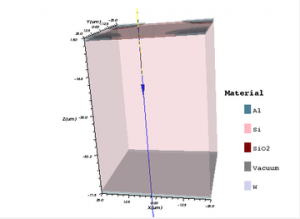 This tutorial is a quick-start guide for simulating Si strip and pixel radiation detector in 2D and 3D, using VisualTCAD and VisualParticle. The behavior of energetic particle is simulated by Monte Carlo simulation, and the behavior of charge carrier is simulated by TCAD simulation. The details of the detector’s transient response can be given.
This tutorial is a quick-start guide for simulating Si strip and pixel radiation detector in 2D and 3D, using VisualTCAD and VisualParticle. The behavior of energetic particle is simulated by Monte Carlo simulation, and the behavior of charge carrier is simulated by TCAD simulation. The details of the detector’s transient response can be given.
- Input:
- for Detector: Layout and Process Rule
- for Radiation: Particle Species and Its Energy, Incident Position, Direction
- Output:
- Tracks of Particles
- Energy Deposition along Tracks
- Device’s Transient Response to Particles
- Energy Resolution of the Detector
ESD protection device: ggNMOS
Tutorial guide | Input file package
 This tutorial illustrates a simulation of ESD discharge characteristics of a ggNMOS device in Genius.
This tutorial illustrates a simulation of ESD discharge characteristics of a ggNMOS device in Genius.
GgNMOS device is commonly used in ICs as ESD protection device. It relies on the turn-on of a parasitic BJT transistor to bypass the large ESD current, and the joule heating in device is a primary reason of its failure. This tutorial covers the physics model needed to model the parasitic device, the impact-ionization effect and thermal effect in ggNMOS. The simulations under the transmission-line pulse (TLP) and human-body mode (HBM) waveforms were demonstrated.
FinFET: with density-gradient quantum correction model
Tutorial guide | Input file package
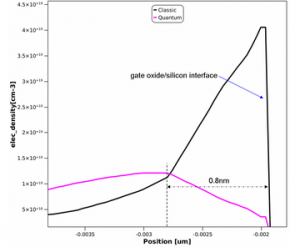 This tutorial describes a simulation of a FinFET devices, and the use of the density gradient model to describe the quantum confinement of inversion carriers.
This tutorial describes a simulation of a FinFET devices, and the use of the density gradient model to describe the quantum confinement of inversion carriers.
In advanced nano scale MOS process technologies, quantum effect becomes more and more important and non-negligible. The density-gradient model is a powerful tool for quantum effect simulationcan in TCAD simulators, and has been demonstrated to be suitable in the simulation of deca-nanometer multi-gate transistors.
Example Gallery
Illustraition: Printed pages
Application examples show what’s possible with our products.
Click the examples to view the descriptions online; when logged in to MyGTS you can also download them as PDF for offline reading, or run them online. In the MyGTS download area, you can also download the respective GTS projects, which you can open in GTS Framework.
Run examples here
Simulate Online
Login to MyGTS to start.
Graduation capsThe graduation caps indicate the sophistication level of the examples.
NDS: Bulk FinFET
This example demonstrates the usage of the GTS Nano Device Simulator to model n-type and p-type bulk FinFETs.
Expert
NDS: Gate-All-Around FinFET
Usage of GTS Nano Device Simulator to model nMOS gate-all-around FinFET transistors: We show Id,lin, Id,sat, extraction of MOS parameters; effects of varying gate length, channel orientation, mechanical stress.
Expert
NDS: Interface Traps
Will be online soon (please use PDF version for now).
Expert
Mechanical Stress
In this example we investigate the effects of mechanical stress in a PMOS FinFET with SiGe Source/Drain Epi layers using GTS VSP and GTS MINIMOS-NT.
Expert
Reliability BTI
This example demonstrates the use of oxide defects in stationary and in transient simulations. The device under test is a 3D planar pMOS device based on the template database of the GTS Framework.
Intermediate
Hot Carrier Degradation
Demonstration of the hot-carrier degradation model implemented in the GTS Framework.
Intermediate
SOI FinFET Discrete Dopants
Minimos-NT simulations obeying the atomistic nature of traps and dopants. Based on a FinFET, the influence of discrete interface and oxide traps as well as discrete dopants on the device characteristics are illustrated.
Expert
SOI FinFET
Basic simulation flow demonstrated on an SOI FinFET. Template based structure generation and different Minimos-NT simulation models, such as Drift Diffusion and Density Gradient.
Intermediate
CMOS Heavy Ion Impact
This example illustrates the simulation of heavy ion impact events in CMOS structures using GTS Framework.
Expert
CMOS Logic
Static and transient analysis of CMOS structures. Starting with single transistors, the complexity is increased up to a full 6-transistor SRAM cell, including the transient simulation of a full write cycle.
Intermediate
SiC Schottky Barrier Diode
SiC4H Schottky Barrier Diode, including Impact Ionization Model and Auger Recombination.
Beginner
SiC Vertical DMOS
SiC vertical DMOS – breakthrough, snapback, electron current density
Beginner
SiC MESFET
This example demonstrates the simulation of SiC devices on the example of a MESFET, including self heating effects.
Beginner
GaN HEMT
Simulation of GaN devices on the example of a High electron mobility Transistor
Interme diate
Radiation Effects
- Single-Event Upsets in CMOS SRAM
- Single-Event Transitent in Analog Circuit
- Total Ionizaing Dose Effects in CMOS
Sensors and Detectors
Electrostatic Discharge
Advanced CMOS
UNIVERSITY PROGRAM
The objective of the University Software Program is to provide easy access to leading TCAD and EDA design tools in support of the education of future semiconductor design engineers.
Flexible Software Licensing
Visual TCAD / Genius can be purchased for a ‘one-time’ payment under a perpetual license agreement. All updates, upgrades and technical support are free for the 1st year. Thereafter, maintenance and technical support contracts are optionally available. We offer the following versions of Visual TCAD / Genius under license agreement.
FEATURE MATRIX | VERSION | ||
BASIC | PROFESSIONAL | ||
VisualTCAD (GUI) | |||
Drift-diffusion solver | |||
Lattice temperature | X | ||
Energy balance solver | X | ||
2D mesh | |||
3D mesh | X | ||
Optical / FEM / Raytracing | X | ||
Circuit and device simulation | |||
Parallel computation | 2 CPUs | 4 CPUs | |
Customized versions of our software are available upon request.
